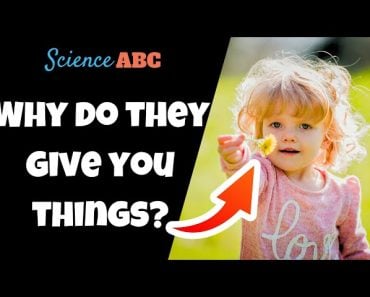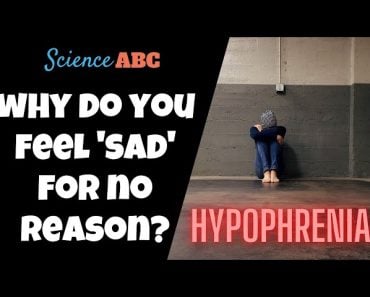Attachment styles relate to how secure we are in our relationships (romantic or otherwise). As the theory goes, these different styles of attachment are dictated by how secure our attachment with our caregivers are or were.
Therapy content on social media is littered with references to attachment theory, from what type of romantic partner you are to how essential is to know your crush’s attachment style before you fall head over heels. However, what is an attachment style and how does it affect our interactions with others?
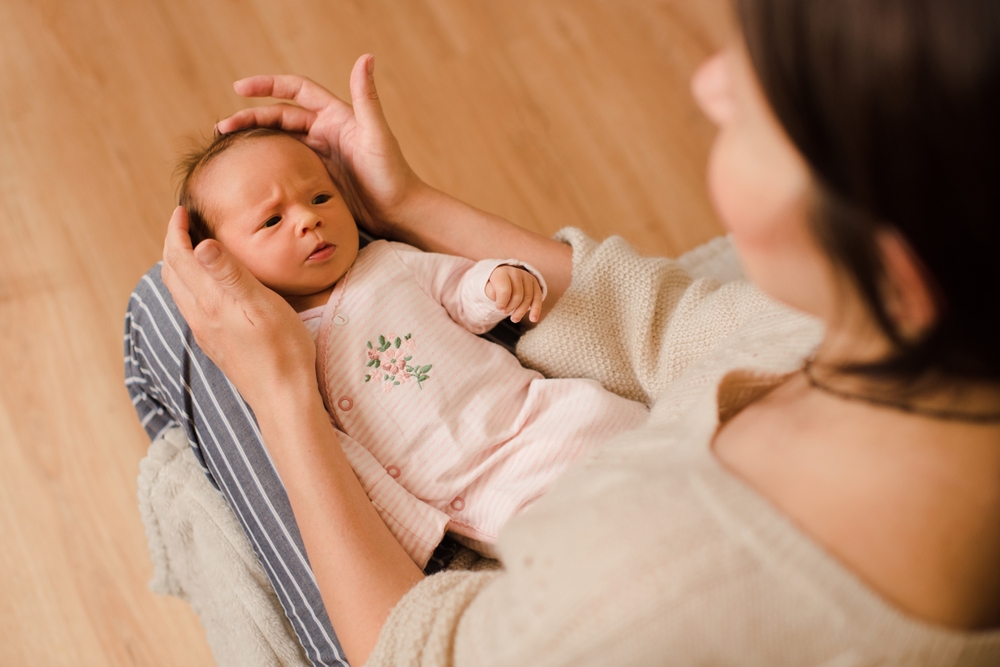
Recommended Video for you:
How Are Attachment Styles Formed?
Online, attachment styles seem to primarily be about romantic relationships. However, the origin of our attachment style (and ultimately, its connection to our love lives) is based on our level of security in a relationship with another person: be it romantic, platonic, or parental. Attachment styles are born of our interactions with our parents and the bond we share with them, and they subsequently affect every relationship in our lives.
Our interaction with our parents shapes our attachment styles, as they are usually the first people we are in contact with after birth. From a young age, we have an inclination to interact with other people, and it is these interactions that shape our social relationships with others throughout our lives.
Edward John Mostyn Bowlby, a British psychologist, was known for his contribution to the concept of attachment theory. He and his colleague Ainsworth carefully studied the interactions between mothers and infants and developed the idea of set attachment styles.
According to Bowlby (seen as the pioneer of the field), infants develop two basic attitudes while interacting with an adult in their early years of life. The first is the infant’s attitude about themselves and their self-esteem. How the caretaker—parent, grandparents, guardians—behave and emotionally respond to the infant show the infant if they are loved as an individual or if they are without value, unloved and unimportant.
The second attitude relates to the expectations and beliefs one has about others in their life, also referred to as interpersonal trust. Is the caretaker seen as someone who is trustworthy, reliable and dependable? Or as someone who is untrustworthy, unreliable, and undependable?
Based on these two basic attitudes, people can be roughly classified into having a particular style of being involved in relationships with others. Think of self-esteem as one dimension and interpersonal trust as another.
Based on this binary, there are four possible patterns that exist: someone who is high on both dimensions, someone low on both dimensions, and two others in which the person in question is high in one dimension and low in the other. We will discuss the four contrasting attachment styles next.
What Are The Different Types Of Attachment Styles?
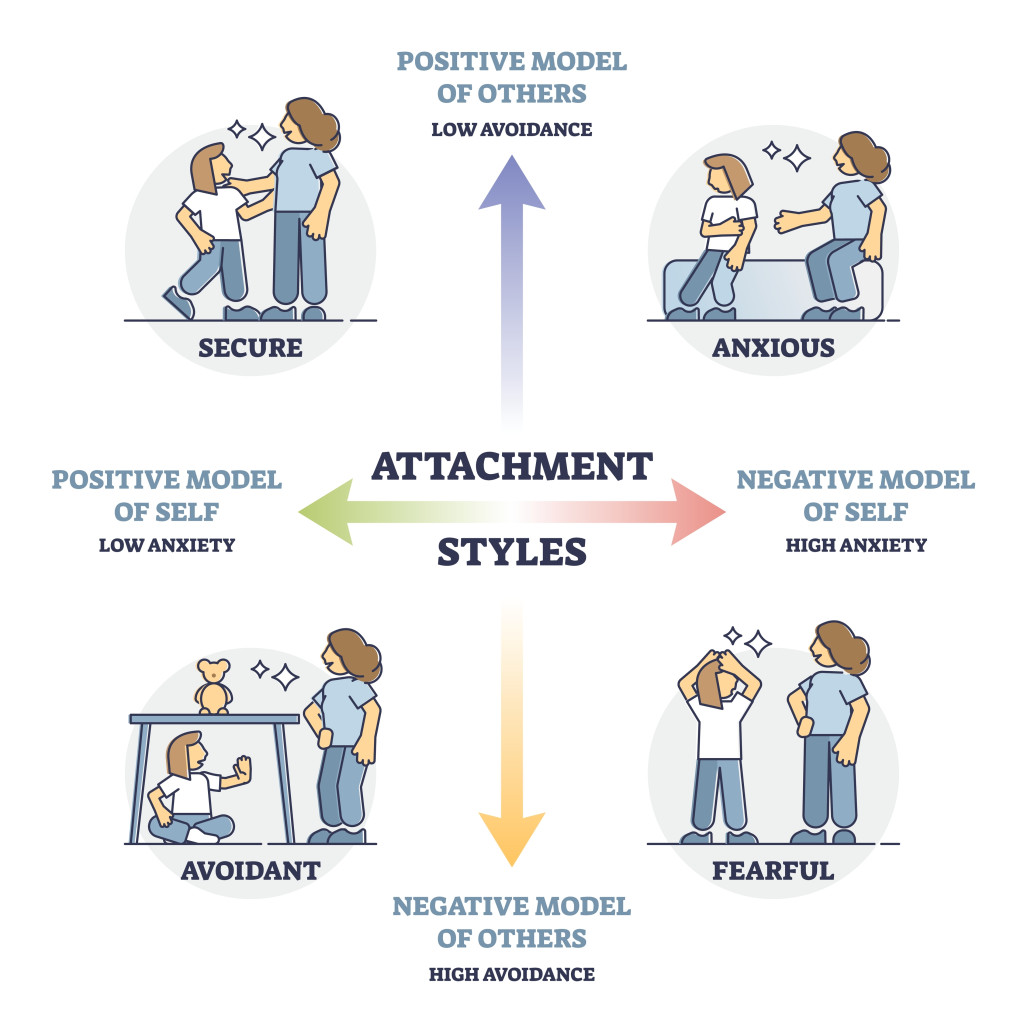
High self-esteem + high interpersonal trust = secure attachment style. These individuals are able sustain committed and satisfying relationships.
High in self-esteem + low interpersonal trust = dismissing (avoidant) attachment style. This combination leads individuals to believe that they deserve good relationships, but they don’t trust others and fear genuine intimacy.
Low self-esteem + high interpersonal trust = preoccupied (anxious) attachment style. Because of low self-esteem, these individuals can become needy and cling onto others because they fear rejection.
Low self-esteem + low interpersonal trust = fearful-avoidant attachment style. This is also called the anxious-avoidant attachment style, as it has the best of both the anxious and the avoidant attachment styles. This combination leads individuals to believe that they deserve good relationships, but they don’t trust others and fear genuine intimacy.
How Do Attachment Styles Affect Our Relationships?
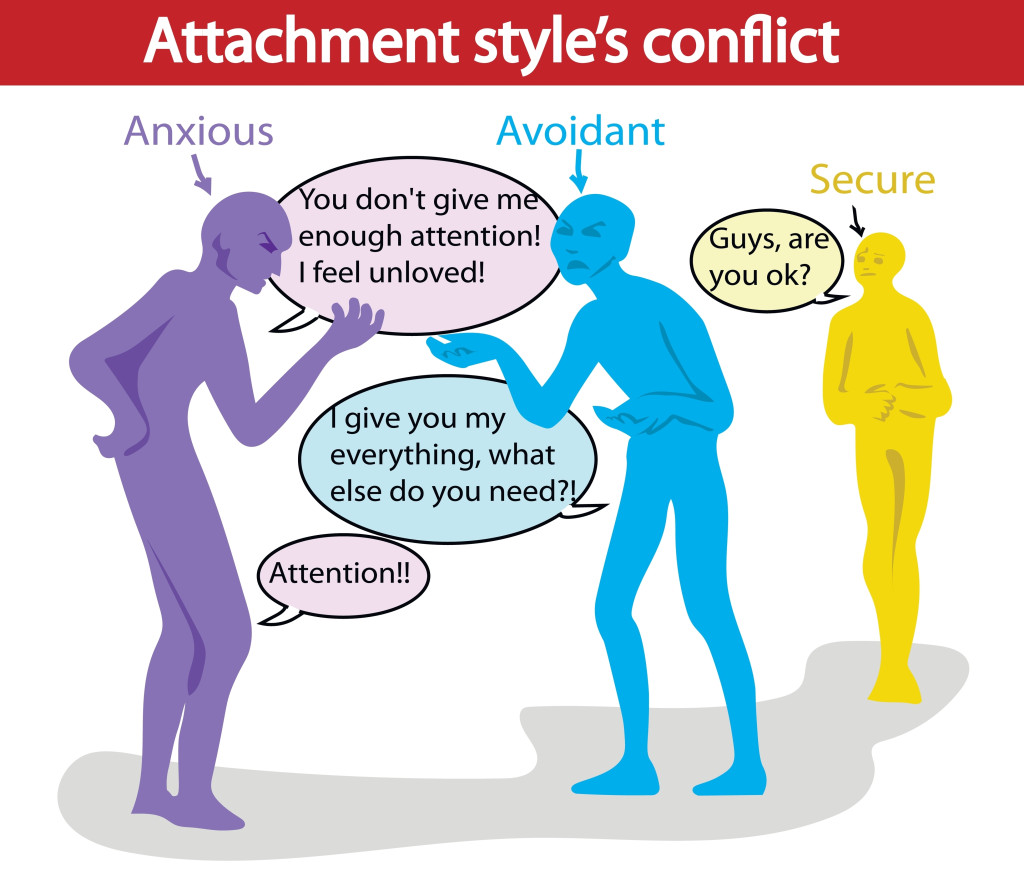
People With Different Attachment Styles Respond Differently In Romantic Relationships (Photo Credit : DreamyNatalie_doodles.J/Shutterstock)
Securely attached individuals are what we would call “emotionally healthy”. As the theory goes, these individuals probably had loving, warm, and emotionally responsive caretakers. As a result, they have a healthy degree of self-esteem and trust in others. They report having happy and trusting relationships, both romantic and platonic, and are themselves loving and dependable people. They can be vulnerable with their partners, they communicate effectively, and are available to meet their partner’s needs.
People who show avoidant attachment styles, on the other hand, are uneasy with getting emotionally close to others. They tend to see their parents as harsh and uncaring, and project that onto other relationships. They see emotional intimacy as suffocating, or believe that it will take away their freedom or independence, and have a negative overall picture of love, believing that it never lasts.
Preoccupied or anxious attachment styles desire intimacy, but view their relationships as being fragile. They also report their parents as being either too involved or extremely absent. Anxiously attached people are the ones who worry if their partners don’t call when they say they will, or if they arrive home late without any explanation. They view these situations as being “dangerous” for their relationships. People with anxious attachment styles find it easy to fall in love, but difficult to sustain it.
Are Attachment Styles Set In Stone? Do They Ever Change?
Our attachment styles have an impact on our life’s outcomes. Young adults with an insecure attachment style have poorer performance in school, as compared to those with a secure attachment style. They have fewer friends, and feel more like an outcast in social situations. They also report having higher levels of stress and conflicts in their relationships. People with a fearful-avoidant style are more likely to report suicidal thoughts and are also more likely to die by suicide.
Fortunately, they are not set in stone. Someone with a secure attachment style who experiences a painful breakup can become temporarily insecure due to the blow that the breakup has on their self-esteem.
Let’s take an example of someone named AyeBee who has an anxious attachment style. Through therapy and self-reflection, they have managed to challenge the negative beliefs they held about love, and addressed the root-cause of his anxious attachment style. This helped him develop a secure sense of self. Gradually, his attachment style shifted, leading to healthier relationships, increased self-worth, and a greater sense of stability and satisfaction.
Challenges/Alternatives To Attachment Theory
The attachment theory has gained huge acceptance among psychologists and psychiatrists, but it is not without its critics. Some alternate theories propose a different explanation for how human relationships and attachments are formed.
Social support theory is one alternative. This theory emphasizes the importance of social networks, community, and other support systems like friendships and workplace relationships in shaping our well-being and emotional security. The main argument of this theory is that attachment is not just related to our early relationship with our caregivers, but actually encompasses all sorts of social interactions that we encounter in our lives.
One of the reasons why attachment theory is popular among psychologists and psychiatrists is because it is a comprehensive framework for understanding behaviors, emotional development, and relationship dynamics of humans. It also provides them a lens through which they can analyze and address attachment-related issues in their therapeutic sessions. Since the theory emphasizes early life experiences, internal working models, and the impact these attachment styles have on mental health, they ultimately influence the course of psychotherapy.
While the attachment theory has its limitations and alternative perspectives do exist, its popularity cannot be denied and its impact cannot be minimized.
References (click to expand)
- Miall, D. S., & Dissanayake, E. (2003, December). The poetics of babytalk. Human Nature. Springer Science and Business Media LLC.
- Bowlby, J. (1979). The Bowlby-Ainsworth attachment theory. Behavioral and Brain Sciences, 2(4), 637-638. doi:10.1017/S0140525X00064955
- Bretherton, I. (1992, September). The origins of attachment theory: John Bowlby and Mary Ainsworth. Developmental Psychology. American Psychological Association (APA).
- Shaver, P. R., & Brennan, K. A. (1992, October). Attachment Styles and the "Big Five" Personality Traits: Their Connections with Each Other and with Romantic Relationship Outcomes. Personality and Social Psychology Bulletin. SAGE Publications.
- Tidwell, M.-C. O., Reis, H. T., & Shaver, P. R. (1996). Attachment, attractiveness, and social interaction: A diary study. Journal of Personality and Social Psychology. American Psychological Association (APA).
- Whiffen, V. E., Aube, J. A., Thompson, J. M., & Campbell, T. L. (2000, June). Attachment Beliefs and Interpersonal Contexts Associated with Dependency and Self-Criticism. Journal of Social and Clinical Psychology. Guilford Publications.
- Carvallo, M., & Gabriel, S. (2006, May). No Man Is an Island: The Need to Belong and Dismissing Avoidant Attachment Style. Personality and Social Psychology Bulletin. SAGE Publications.
- Shaver, P. R., & Brennan, K. A. (1992, October). Attachment Styles and the "Big Five" Personality Traits: Their Connections with Each Other and with Romantic Relationship Outcomes. Personality and Social Psychology Bulletin. SAGE Publications.
- Klohnen, E. C., & Bera, S. (1998). Behavioral and experiential patterns of avoidantly and securely attached women across adulthood: A 31-year longitudinal perspective. Journal of Personality and Social Psychology. American Psychological Association (APA).
- Verhaar, S., Matthewson, M. L., & Bentley, C. (2022, March 30). The Impact of Parental Alienating Behaviours on the Mental Health of Adults Alienated in Childhood. Children. MDPI AG.
- (PDF) Divorce through the Lens of Attachment Theory. ResearchGate
- Feeney, B. C., & Collins, N. L. (2014, August 14). A New Look at Social Support. Personality and Social Psychology Review. SAGE Publications.











